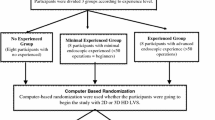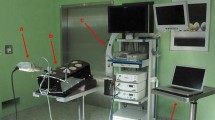Abstract
In this study, the impact of two-dimensional (2D) and three-dimensional (3D) vision on laparoscopic performance of novice surgeons is examined. Twenty-five novice surgeons were directed to complete four basic tasks from European Training in Basic Laparoscopic Urological Skills (E-BLUS) with both 2D and 3D systems in a random order: task 1: needle guidance, task 2: cutting a circle, task 3: laparoscopic suturing, and task 4: pegs transfer. Quality and quantity scores for each task were measured. Participants completed all of the tasks in one modality of vision and than switched to the other. NASA Task Load Index was used for subjective workload assessment. Statistically significant differences in favor of 3D vision were detected in tasks 1 and 4 both in terms of quality and quantity. In task 2 and task 3, a significantly better performance was observed with the 3D vision only in quantity assessment. The participants who started the tasks in the 3D vision were better in performing the skills in 2D when compared to the participants who started with 2D vision. Overall, the participants reported a better perception of depth and spatial orientation with the 3D mode. Subjective work load was also lower for the tasks performed in 3D. Novice surgeons tended to perform better and felt much more comfortable with 3D in comparison to 2D laparoscopy. Even though previous task experience seemed to have an important impact on laparoscopic performance regardless of imaging modality, 3D laparoscopy seemed to facilitate the learning for novice surgeons.





Similar content being viewed by others
References
Hatzinger M, Badawi JK, Hacker A, Langbein S, Honeck P, Alken P (2006) Georg Kelling (1866–1945): the man who introduced modern laparoscopy into medicine. Der Urologe Ausg A 45(7):868–871. doi:10.1007/s00120-006-1068-9
Heemskerk J, Zandbergen R, Maessen JG, Greve JW, Bouvy ND (2006) Advantages of advanced laparoscopic systems. Surg Endosc 20(5):730–733. doi:10.1007/s00464-005-0456-3
Becker H, Melzer A, Schurr MO, Buess G (1993) 3-D video techniques in endoscopic surgery. Endosc Surg Allied Technol 1(1):40–46
Hofmeister J, Frank TG, Cuschieri A, Wade NJ (2001) Perceptual aspects of two-dimensional and stereoscopic display techniques in endoscopic surgery: review and current problems. Semin Laparosc Surg 8(1):12–24
Kong SH, Oh BM, Yoon H, Ahn HS, Lee HJ, Chung SG, Shiraishi N, Kitano S, Yang HK (2010) Comparison of two- and three-dimensional camera systems in laparoscopic performance: a novel 3D system with one camera. Surg Endosc 24(5):1132–1143. doi:10.1007/s00464-009-0740-8
Lusch A, Bucur PL, Menhadji AD, Okhunov Z, Liss MA, Perez-Lanzac A, McDougall EM, Landman J (2014) Evaluation of the impact of three-dimensional vision on laparoscopic performance. J Endourol Endourological Soc 28(2):261–266. doi:10.1089/end.2013.0344
Wilhelm D, Reiser S, Kohn N, Witte M, Leiner U, Muhlbach L, Ruschin D, Reiner W, Feussner H (2014) Comparative evaluation of HD 2D/3D laparoscopic monitors and benchmarking to a theoretically ideal 3D pseudodisplay: even well-experienced laparoscopists perform better with 3D. Surg Endosc. doi:10.1007/s00464-014-3487-9
Storz P, Buess GF, Kunert W, Kirschniak A (2012) 3D HD versus 2D HD: surgical task efficiency in standardised phantom tasks. Surg Endosc 26(5):1454–1460. doi:10.1007/s00464-011-2055-9
McDougall EM, Soble JJ, Wolf JS Jr, Nakada SY, Elashry OM, Clayman RV (1996) Comparison of three-dimensional and two-dimensional laparoscopic video systems. J Endourol Endourological Soc 10(4):371–374
Fernandopulle SM, Hwang JS, Kuick CH, Lui J, Tan PH, Siow WY, Wong M (2006) Rosai-Dorfman disease of the testis: an unusual entity that mimics testicular malignancy. J Clin Pathol 59(3):325–327. doi:10.1136/jcp.2005.028423
Hart S, Staveland L (1988) Development of NASA-TLX (Task Load Index): results of empirical and theoretical research. Human mental workload Amsterdam: North Holland (pp. 139–183)
Mean Opinion Score (1996–08) International Telecommunication Union recommendation p800 http://www.itu.int/rec/T-REC-P.800-199608-I/en
Cicione A, Autorino R, Breda A, De Sio M, Damiano R, Fusco F, Greco F, Carvalho-Dias E, Mota P, Nogueira C, Pinho P, Mirone V, Correia-Pinto J, Rassweiler J, Lima E (2013) Three-dimensional vs standard laparoscopy: comparative assessment using a validated program for laparoscopic urologic skills. Urology 82(6):1444–1450. doi:10.1016/j.urology.2013.07.047
Honeck P, Wendt-Nordahl G, Rassweiler J, Knoll T (2012) Three-dimensional laparoscopic imaging improves surgical performance on standardized ex-vivo laparoscopic tasks. J Endourol Endourological Soc 26(8):1085–1088. doi:10.1089/end.2011.0670
Sun CC, Chiu AW, Chen KK, Chang LS (2000) Assessment of a three-dimensional operating system with skill tests in a pelvic trainer. Urol Int 64(3):154–158
Ethical statement
There were no ethical considerations; no patients were involved in this study. The participants were doctors and students. No personal data was obtained and no treatment was applied to any of the participants.
As there were no ethical considerations, an ethical committee approval was not obtained.
Conflict of interest
None
Author information
Authors and Affiliations
Corresponding author
Rights and permissions
About this article
Cite this article
Özsoy, M., Kallidonis, P., Kyriazis, I. et al. Novice surgeons: do they benefit from 3D laparoscopy?. Lasers Med Sci 30, 1325–1333 (2015). https://doi.org/10.1007/s10103-015-1739-0
Received:
Accepted:
Published:
Issue Date:
DOI: https://doi.org/10.1007/s10103-015-1739-0




